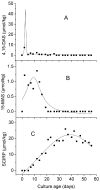Accumulation kinetics of three scirpentriol-based toxins in oats inoculated in Vitro with isolates of Fusarium sporotrichioides and Fusarium poae
- PMID: 22069718
- PMCID: PMC3202831
- DOI: 10.3390/toxins3050442
Accumulation kinetics of three scirpentriol-based toxins in oats inoculated in Vitro with isolates of Fusarium sporotrichioides and Fusarium poae
Abstract
Autoclaved oats were inoculated with a strain of Fusarium sporotrichioides or Fusarium poae. Moisture content of oats after inoculation was at 38%, incubation took place in standing culture at 28 °C. The A-type trichothecenes, 4,15-diacetoxyscirpenol (4,15-DAS), 15-monoacetoxyscirpenol (15-MAS), and scirpentriol (SCIRP) were analyzed by GC/MS. For each strain, three culture flasks were harvested at 2-3 day intervals starting immediately after inoculation. Total incubation time was 42 days (F. poae) and 56 days (F. sporotrichioides). Following peak accumulation, 4,15-DAS decreased below the detection limit for both strains, 15-MAS decreased below this limit for the isolate of F. sporotrichioides, for the isolate of F. poae it decreased to a level markedly below the peak value. SCIRP, after having peaked, decreased to some extent for the strain F. sporotrichioides, with a significant (P = 0.0029) negative linear regression of toxin content against culture age during this period. The content of 15-MAS, and in part also of 4,15-DAS, decreased along with an increase of SCIRP. This sequential accumulation pattern suggests the successive induction of esterases deacetylating 4,15-DAS and 15-MAS, as well as of enzymes involved in the metabolization of the parent alcohol, SCIRP. The results may explain, at least in part, the somewhat higher incidence in naturally contaminated compounds reported in the literature for SCIRP compared to 4,15-DAS and 15-MAS.
Keywords: Fusarium poae; Fusarium sporotrichioides; oats; scirpentriol toxins; sequential accumulation; toxigenicity; trichothecenes.
Figures


References
-
- DeNijs M., Rombouts F.M., Notermans S.H.W. Fusarium molds and their mycotoxins. J. Food Safety. 1996;16:15–58. doi: 10.1111/j.1745-4565.1996.tb00150.x. - DOI
-
- Pitt J.I., Hocking A.D. Fungi and Food Spoilage. 2nd. Aspen Publishers; Gaithersburg, MD, USA: 1999.
-
- Miller J.D., Young J.C., Trenholm H.L. Fusarium toxins in field corn. I. Time course of fungal growth and production of deoxynivalenol and other mycotoxins. Can. J. Bot. 1983;61:3080–3087.
-
- Miller J.D., Taylor A., Greenhalgh R. Production of deoxynivalenol and related compounds in liquid culture by Fusarium graminearum. Can. J. Microbiol. 1983;29:1171–1178. doi: 10.1139/m83-179. - DOI
MeSH terms
Substances
LinkOut - more resources
Full Text Sources
Miscellaneous

